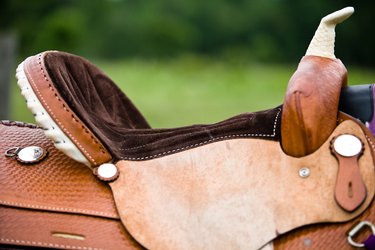
"Saddle leather" is a catch-all term for heavy-duty cowhide, be it on a saddle bag, bicycle saddle, belt, or a saddle itself. You can dye saddle leather easily with a few simple materials, depending upon the type of finish you want, and how you will use the item.
Types
Video of the Day
Several types of dye are suited to saddle leather. The most available and least expensive are the spirit dyes, which include alcohol. The alcohol helps the dye penetrate the leather.
Video of the Day
A second variety, which produces the best finish, is the oil dyes. These are the same formulation as the spirit dyes, but with some oil added, which further helps in penetration. Oil dyes generally produce a better first coat, and a better overall saturation.
A third kind is called a dye, but is really acrylic paint. This is the type that upholsterers and cobblers sell. Rather than penetrate the leather, this coats the leather. This is not a cheap approach; practically all of your leather goods, from auto upholstery to furniture to leather jackets, are painted.
A new variety is the water-based variety, like Fiebing's Eco-Flo products. The results are generally satisfactory, and the idea is to produce dyes that contain no carcinogens, volatile organic compounds (VOCs) and so on, but it is more difficult to achieve a consistent color with these than with the oil- or spirit-based dyes.
A final variety is the antique finishes. These resemble shoe cream. They are wax-based, and rather than penetrate the leather, they sit on top of it, and bring out any tooling or carving. Use these on top of one of the other types of dyes.
Considerations
"I have successfully dyed a Brooks saddle, which subsequently dyed the seat of my pants successfully," wrote a disgruntled rider on the online resource BikeForums.net (see References 2).
All of the dyes (but for the acrylic paint variety) are prone to rubbing off onto clothing. This is what keeps most people from dyeing an old brown saddle black with oil- or spirit-based dye. Cyclists who buy an expensive Brooks leather saddle, and wish to dye it to match the bicycle, are better off painting the saddle; the acrylic "dyes" let leather breathe fairly well.
Prevent rub-off with a protectant, which seals the leather but allows it to breathe. Two quality makers include Lexol and Leather World Technologies, who provide leather products for upholstery.
You can only dye an item darker, and, you must consider any original finish. You cannot dye a brown object blue; you will likely get black. You cannot dye a blue object yellow; you will get a muddy, unpleasant green. You will achieve your best results dyeing unfinished leather to a color.
Preparation
As important as the dyeing itself is the preparation. Any cowhide you buy will have some oils and waxes, and a manufactured item like a saddlebag or coat will likely have some protectants as well. You must strip off all of the protectants, to prepare the leather to accept dye; otherwise, it is like attempting to paint onto plastic — the dye simply will not take.
Use a deglazer of volatile organic compounds (like benzene or toluene) first to remove any coatings, then to enable penetration. Leather crafters achieve the best color finish when the leather is still wet with deglazer. It acts like paint thinner, which enables paint to penetrate wood.
Purchase deglazers and preparers in large quantities; an 8-oz. bottle may suit a small job, but for anything larger, purchase a 1L or 1/2-gallon container. When using dye, less is more; when using deglazer, more is more.